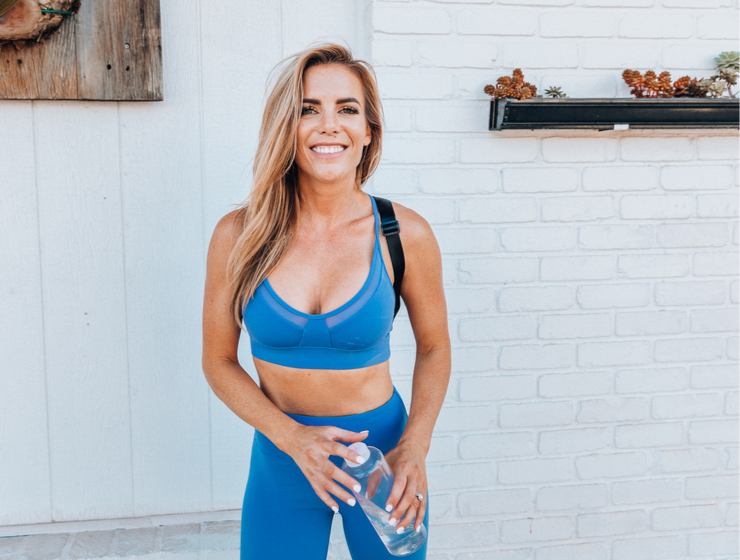
Muscle soreness is something that we’ve all experienced and deal with from time to time, but how much do you really know about it? And beyond that, do you know the best way to cope with it when you wake up in the morning and can barely lower your sore buns onto the toilet to pee? #sotrue
I want you to have all of the tools you need to get through this challenge, and every future challenge, feeling your best! So keep reading to find out all about soreness, when it’s good and when it’s not, and how you can cope with it when it sneaks up on you!
What The Heck Is It?
First things first, “what really is soreness?” Well, there are two main types of muscle soreness. One is acute muscle soreness, which is that burning sensation that shows up during or immediately after your workout and is caused by a buildup of lactic acid. This type of soreness should resolve itself quickly.
The other type is delayed onset muscle soreness (otherwise known as DOMS), which is the pain and stiffness you feel 24-72 hours after your workout, and is due to inflammation and microtears in your muscles. These teeny itty bitty tears occur when you’ve pushed your body passed what it’s used to (level up, girl!), but these tears heal within days, and leave your muscles stronger than before!
What The Heck Is It?
First things first, “what really is soreness?” Well, there are two main types of muscle soreness. One is acute muscle soreness, which is that burning sensation that shows up during or immediately after your workout and is caused by a buildup of lactic acid. This type of soreness should resolve itself quickly.
The other type is delayed onset muscle soreness (otherwise known as DOMS), which is the pain and stiffness you feel 24-72 hours after your workout, and is due to inflammation and microtears in your muscles. These teeny itty bitty tears occur when you’ve pushed your body passed what it’s used to (level up, girl!), but these tears heal within days, and leave your muscles stronger than before!
How Do I Treat It?
Now that we’re clear on what all of that pain and stiffness is, let’s talk about how to treat it! There’s not much that will take away your soreness completely, but there are several things you can do in the hours and days after your workout to help ease the pain of sore muscles, even just a liiiiittle bit!
After your workout, take a warm bath or sit in the hot tub for 20-30 minutes. If you want double the benefits, add some epsom salts to your bath for reduction of any inflammation in your muscles!
After heat therapy, take an ice bath (if you’re brave enough!) or use ice packs on trouble spots to help reduce nerve activity and treat inflammation.
Another handy dandy tool is the arnica flower – it’s a fabulous little herb that’s been used to treat pain and swelling for centuries, and has been popular due to its supposed anti-inflammatory properties – sound amazing? That’s because it is! Try to find a cream with arnica in it to have on hand so you can massage it into extra sore muscles and all you have to do is sit back and let it work its magic!
This next tip may be a no-brainer for you, but it’s so sooo important. Foam rolling, or massages, can help break up the lactic acid building up in your muscles, reducing delayed onset soreness. Breaking down that acid plays a big roll in your ability to feel minimal pain from muscle soreness.
Lastly, make sure that you cool down sufficiently after your workout. Continuing to move around will keep your muscles from becoming too stiff and will allow you to stay loose as you recover.
What Do I Eat?
Fascinatingly enough, remedies for soreness carry over from the gym to the kitchen, and there are certain foods that you can eat or avoid to set your muscles up for pain-free success! Focus on foods rich in omega-3 and antioxidants, such as salmon, turmeric, blueberries, kale, and ginger. Coffee is another good thing to have both before and after your workout, as it delivers antioxidants to your body as well as caffeine, which can help reduce soreness as well – ahhhhmazing, right?!
Likewise, be sure to avoid alcohol as it dehydrates your muscles and exacerbates your soreness, and steer clear of sugar as well as it can make inflammation worse, causing more pain.
Can I Prevent It?
Helping to prevent soreness also involves things like being consistent with your workouts so you’re not losing progress, staying extra hydrated so your muscles have everything they need to be pushed and recover, and making sure that you’re staying in tune with how hard you can push your body to promote growth without causing any damage that will keep you from hitting the gym. Make sure also to be stretching regularly and doing yoga to help prevent any injury while you’re gettin’ after it! Download the LSF App for full length stretch routines!
All in all, there are plenty of ways to prevent and treat soreness, but remember – unless it’s lasting a prolonged period of time, muscle soreness is a very good thing and is an indicator that your muscles are getting stronger and your fitness is reaching new levels!
So now that you have allllll of this helpful info, get out there and kick some serious BOO-ty! I’m so excited to see how you use this month to level up on your goals and continue to push yourself to be better, and if you have your own tips and tricks for avoiding crazy sore muscles the day after a difficult sweat sesh, let us know!!
